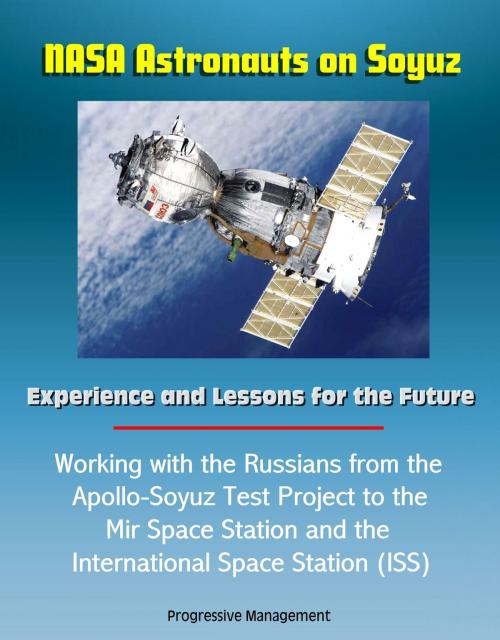NASA Astronauts on Soyuz: Experience and Lessons for the Future - Working with the Russians from the Apollo-Soyuz Test Project to the Mir Space Station and the International Space Station (ISS)
Nonfiction, Science & Nature, Technology, Aeronautics & Astronautics, Science, Physics, Astrophysics & Space Science| Author: | Progressive Management | ISBN: | 9781476027203 |
| Publisher: | Progressive Management | Publication: | May 10, 2012 |
| Imprint: | Smashwords Edition | Language: | English |
| Author: | Progressive Management |
| ISBN: | 9781476027203 |
| Publisher: | Progressive Management |
| Publication: | May 10, 2012 |
| Imprint: | Smashwords Edition |
| Language: | English |
This official NASA document - converted for accurate flowing-text ebook format reproduction - provides an interesting review of NASA's experience working with the Russians and lessons on astronaut safety assurance of the Soyuz spacecraft. This report on Soyuz history was conceived as a possible analogy relevant to domestic commercial spaceflight vehicles.
The question of how to human-rate new spacecraft has been asked many times throughout the history of human spaceflight. The U. S., Russia, and, now China have each separately and successfully addressed this question. NASA's operational experience with human-rating primarily resides with Mercury, Gemini, Apollo, Space Shuttle, and the International Space Station (ISS). NASA's latest developmental experience includes Constellation, but also encompasses X38, X33, and the Orbital Space Plane.
If domestic commercial crew vehicles are used to transport astronauts to and from space, the Soyuz vehicle would be another relevant example of the methods that could be used to human-rate a spacecraft and how to work with commercial spacecraft providers.
As known from history, the first U.S. astronaut to orbit on a Soyuz spacecraft was Thomas P. Stafford on July 17, 1975, during the Apollo-Soyuz Test Project (ASTP) mission. Norman E. Thagard was the first U.S. astronaut to launch on a Soyuz launch vehicle, Soyuz TM-21, on March 14, 1995, on a flight to the Russian Mir Space Station. This flight was associated with the U.S./Russian - Shuttle/Mir Program. The first Soyuz launched to ISS included astronaut William M. Shepherd, Soyuz TM-31, on October 31, 2000. Prior to this, NASA studied Soyuz as an assured crew return vehicle (ACRV) for Space Station Freedom (SSF) to be launched on the Space Shuttle. Presently, in preparation for Space Shuttle retirement, all U.S. astronauts are being transported to and from ISS in the Russian Soyuz spacecraft, which is launched on the Soyuz launch vehicle.
In the case of Soyuz, NASA's normal assurance practices have had to be adapted. For a variety of external reasons, NASA has taken a "trust but verify" approach to Soyuz and international cargo vehicles. The verify approach was to perform joint safety assurance assessments of the critical spacecraft systems. For Soyuz, NASA's primary assurance was (and continues to be) its long and successful flight history. The other key measure relied on diverse teams of NASA's best technical experts working very closely with their foreign counterparts to understand the essential design, verification, and operational features of Soyuz. Those experts used their personal experiences and NASA's corporate knowledge (in the form of agency, program, center, and other standards) to jointly and independently assess a wide range of topics.
This official NASA document - converted for accurate flowing-text ebook format reproduction - provides an interesting review of NASA's experience working with the Russians and lessons on astronaut safety assurance of the Soyuz spacecraft. This report on Soyuz history was conceived as a possible analogy relevant to domestic commercial spaceflight vehicles.
The question of how to human-rate new spacecraft has been asked many times throughout the history of human spaceflight. The U. S., Russia, and, now China have each separately and successfully addressed this question. NASA's operational experience with human-rating primarily resides with Mercury, Gemini, Apollo, Space Shuttle, and the International Space Station (ISS). NASA's latest developmental experience includes Constellation, but also encompasses X38, X33, and the Orbital Space Plane.
If domestic commercial crew vehicles are used to transport astronauts to and from space, the Soyuz vehicle would be another relevant example of the methods that could be used to human-rate a spacecraft and how to work with commercial spacecraft providers.
As known from history, the first U.S. astronaut to orbit on a Soyuz spacecraft was Thomas P. Stafford on July 17, 1975, during the Apollo-Soyuz Test Project (ASTP) mission. Norman E. Thagard was the first U.S. astronaut to launch on a Soyuz launch vehicle, Soyuz TM-21, on March 14, 1995, on a flight to the Russian Mir Space Station. This flight was associated with the U.S./Russian - Shuttle/Mir Program. The first Soyuz launched to ISS included astronaut William M. Shepherd, Soyuz TM-31, on October 31, 2000. Prior to this, NASA studied Soyuz as an assured crew return vehicle (ACRV) for Space Station Freedom (SSF) to be launched on the Space Shuttle. Presently, in preparation for Space Shuttle retirement, all U.S. astronauts are being transported to and from ISS in the Russian Soyuz spacecraft, which is launched on the Soyuz launch vehicle.
In the case of Soyuz, NASA's normal assurance practices have had to be adapted. For a variety of external reasons, NASA has taken a "trust but verify" approach to Soyuz and international cargo vehicles. The verify approach was to perform joint safety assurance assessments of the critical spacecraft systems. For Soyuz, NASA's primary assurance was (and continues to be) its long and successful flight history. The other key measure relied on diverse teams of NASA's best technical experts working very closely with their foreign counterparts to understand the essential design, verification, and operational features of Soyuz. Those experts used their personal experiences and NASA's corporate knowledge (in the form of agency, program, center, and other standards) to jointly and independently assess a wide range of topics.















